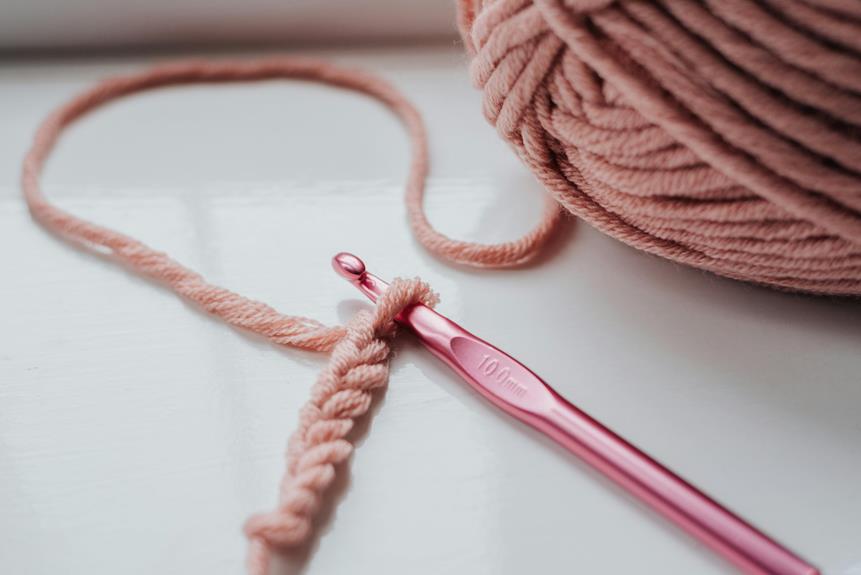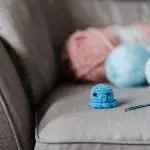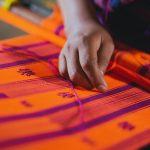If you're looking to add some structure to your fabric projects, DIY fabric stiffening solutions could be just what you need. You can easily whip up a starch solution, or perhaps experiment with a sugar water mixture for lighter fabrics. If you're after something more durable, the gelatin method might catch your interest. Each option offers unique benefits, suitable for everything from hats to decorative pieces. Curious about how these methods compare and which might work best for your next project?
Table of Contents
Key Takeaways
- Use a cornstarch solution for a simple, effective stiffening agent; mix 1 tbsp cornstarch with 1 cup water and heat until thickened.
- Create a sugar water mixture with equal parts sugar and water for lightweight fabrics, providing a crisp finish.
- For a durable option, try a gelatin method; mix 1 tbsp gelatin with 1 cup water for a stiffening solution.
- Combine equal parts white craft glue and water for a versatile stiffening mixture, ideal for hats and decorative projects.
Starch Solutions
Starch solutions are a simple and effective way to stiffen fabric for your DIY projects. You can easily make your own fabric stiffener with just a few ingredients. Start by mixing cornstarch with water in a pot. For every cup of water, use about one tablespoon of cornstarch. Stir the mixture over medium heat until it thickens. Once it's the right consistency, let it cool before applying.
To use your starch solution, dip your fabric into the mixture, ensuring it's fully saturated. You can also spray the solution onto the fabric for more control. After applying, shape the fabric as desired. Remember, the stiffness will depend on how much solution you use and how dry you let it get.
Once you're satisfied with the shape, let the fabric dry completely. You can speed up this process by using a hairdryer on a low setting. If you want an even stiffer finish, you can repeat the dipping or spraying process.
Using starch solutions not only helps with shaping but also adds a subtle sheen to your fabric, enhancing its overall appearance. Enjoy experimenting with different fabrics and projects to find what works best for you!
Sugar Water Mixture
When you're ready to make a sugar water mixture for stiffening fabric, you'll need to know the right recipe and ratios to get the best results.
You'll also want to explore application techniques to ensure even coverage and effective stiffening.
Recipe and Ratios
To create an effective sugar water mixture for stiffening fabric, you'll need to combine equal parts sugar and water. This simple solution works well for lightweight fabrics, giving them a crisp finish without compromising their structure. Here's a quick reference table to help you with measurements:
| Sugar (cups) | Water (cups) |
|---|---|
| 1 | 1 |
| 2 | 2 |
| 3 | 3 |
| 4 | 4 |
| 5 | 5 |
You can adjust the amounts based on how much fabric you're working with. For instance, if you want to stiffen a larger piece, simply increase both the sugar and water while maintaining the equal ratio. Once you mix the sugar and water, heat the solution gently until the sugar dissolves completely. Allow it to cool before using it on your fabric. This mixture not only adds stiffness but also a slight sheen, making your projects look polished. Remember, the thicker the fabric, the more sugar water you may need to achieve the desired stiffness.
Application Techniques
Applying the sugar water mixture effectively can greatly enhance the stiffness of your fabric, so it's important to use the right techniques.
First, consider the type of fabric you're working with; lightweight fabrics like cotton or lace absorb the mixture differently than heavier fabrics like denim. Start by preparing your mixture according to the recipe you've chosen.
Next, lay your fabric flat on a clean, dry surface. Use a paintbrush or sponge to apply the sugar water mixture evenly over the fabric. Make sure to saturate the fabric without soaking it, as too much moisture can lead to uneven stiffness. If you want more control over the stiffness, you can apply the mixture in layers, letting each layer dry slightly before adding more.
For intricate designs or shapes, you might want to use a spray bottle to apply the mixture gently. This method allows for more precision, especially if you're stiffening specific areas.
Once you've fully coated the fabric, gently manipulate it into your desired shape before proceeding to the next step. These techniques will ensure your fabric stiffens beautifully and holds its form.
Drying Process Tips
After you've applied the sugar water mixture, allow your fabric to dry in a well-ventilated area to achieve the best stiffness results. This step is crucial because proper air circulation helps the sugar to crystallize evenly, ensuring a firm finish. If possible, hang your fabric up to dry. This not only prevents wrinkles but also allows gravity to assist in the stiffening process.
Avoid placing your fabric in direct sunlight, as excessive heat can cause the sugar to break down, resulting in a sticky residue. Instead, choose a shady spot or an area with gentle airflow. If you're in a hurry, you can use a fan to speed up the drying process, but make sure it's not blowing directly onto the fabric to prevent unwanted movement or distortion.
Keep an eye on the fabric as it dries. Depending on the thickness, it may take a few hours to fully set. Once it's dry, you can test the stiffness by gently bending it. If it needs more rigidity, you can reapply the sugar water mixture and repeat the drying process.
Enjoy your beautifully stiffened fabric!
Gelatin Method
If you're looking to stiffen fabric with a natural approach, the gelatin method is a great option.
You'll need some simple ingredients and follow a few straightforward steps to achieve your desired stiffness.
Let's explore what you'll need, how to do it, and some tips for the best results.
Ingredients You'll Need
To create a stiffening solution using gelatin, you'll need just a few simple ingredients: unflavored gelatin, water, and optional additives for scent or color. Unflavored gelatin is the star of this method, as it provides the necessary stiffness and structure to your fabric. You can usually find it in the baking aisle of your local grocery store.
For the water, you'll want to use a clean, room-temperature option. The ratio of gelatin to water can vary depending on how stiff you want your fabric to be, but a common starting point is one tablespoon of gelatin to one cup of water. Adjust this ratio to suit your project.
If you'd like to add a personal touch, consider throwing in some optional additives. A few drops of essential oil can give your fabric a pleasant scent, while food coloring or fabric dye can add a splash of color to the solution. Just remember, the additives should be safe for your fabric type.
Gather these ingredients, and you'll be all set to create your custom stiffening solution!
Step-by-Step Instructions
Start by measuring one tablespoon of unflavored gelatin and one cup of room-temperature water in a mixing bowl. Stir them together until the gelatin completely dissolves.
Let the mixture sit for about 5 minutes to allow it to bloom. You'll notice that it thickens slightly during this time.
Next, place the mixing bowl in a microwave and heat it for about 10 to 15 seconds. Stir again to ensure it's evenly mixed. If you find any undissolved gelatin, heat it for a few more seconds until everything is smooth.
Now, take the fabric you want to stiffen and dip it into the gelatin solution. Make sure the fabric is fully submerged for even coverage. Once soaked, lift the fabric out and gently squeeze off any excess gelatin. You don't want it dripping.
Lay the fabric flat on a clean, dry surface. You can also shape it to your desired form while it dries. Allow it to air dry completely, which may take several hours or overnight.
Once dry, you'll have a beautifully stiffened fabric ready for your project!
Tips for Best Results
For the best results with the gelatin method, always ensure your fabric is clean and free from any oils or dirt before soaking it in the solution. This will help the gelatin adhere properly and create a firm finish.
When preparing your gelatin mixture, use the right ratio of gelatin to water; typically, one tablespoon of gelatin to one cup of water works well for most fabrics. Make sure to dissolve the gelatin completely in warm water to avoid any clumps that could affect the stiffness.
After soaking your fabric, gently squeeze out excess solution without rinsing; this allows the gelatin to penetrate the fibers better. While working, keep an eye on the time. If you soak the fabric too long, it might become overly stiff or brittle.
For uniform stiffness, ensure the fabric lies flat while it dries, and consider using a frame or mold to maintain the desired shape. Lastly, let your fabric dry completely in a well-ventilated area. This helps prevent any musty smells and ensures the stiffness holds.
White Glue Mixture
A simple white glue mixture can effectively stiffen fabric, making it an ideal choice for various DIY projects. To create your own, gather white craft glue, water, and a mixing bowl. You'll want to mix equal parts of glue and water—this ratio provides a good balance between stiffness and flexibility.
Once you've combined the glue and water, stir it well until you achieve a smooth consistency. You can now dip your fabric into the mixture, ensuring it's fully saturated. For best results, use a brush to apply the mixture onto the fabric, especially for intricate designs. This method gives you more control over how much stiffening you apply.
After applying the mixture, lay the fabric flat on a clean surface or hang it to dry. The drying time can vary depending on the thickness of the fabric and the environment, so keep an eye on it. Once it's dry, you'll notice a satisfying stiffness that holds its shape beautifully.
This white glue mixture is perfect for crafting projects like homemade hats, decorative elements, or even fabric bowls. Enjoy experimenting with different fabrics and designs!
Cornstarch Paste
Another effective method for stiffening fabric is using a simple cornstarch paste, which offers a natural alternative to white glue mixtures.
To create this paste, you'll need cornstarch, water, and a saucepan. Start by mixing one part cornstarch with two parts cold water in the saucepan. Stir until the cornstarch is fully dissolved. Then, place the mixture on medium heat, continuously stirring until it thickens—this usually takes around 5 to 10 minutes. Once you achieve a smooth, thick consistency, remove it from the heat and let it cool slightly.
Before applying the paste, you may want to test it on a scrap piece of fabric to ensure it provides the desired stiffness without altering the fabric's color.
To use the cornstarch paste, dip your fabric into the mixture, ensuring it's fully saturated. You can also brush it onto the fabric if you prefer a more controlled application.
After coating, lay the fabric flat on a clean surface or hang it to dry. As it dries, the cornstarch will harden, giving your fabric a crisp and structured look.
This eco-friendly solution is perfect for craft projects or DIY home decor!
Spray Stiffener Recipe
Create your own fabric stiffener spray with just a few simple ingredients found in your kitchen. You'll need 1 cup of water, 1 tablespoon of cornstarch, and 1 tablespoon of white school glue or fabric glue. This easy recipe gives you control over the stiffness of your fabric projects.
Start by heating the water in a saucepan until it's warm but not boiling. In a separate bowl, mix the cornstarch with a little cold water to create a slurry.
Once the water's warm, slowly whisk in the cornstarch mixture, ensuring there are no lumps. Keep stirring until the mixture thickens, which usually takes a couple of minutes. Remove it from heat and let it cool slightly.
Next, add the white glue and stir thoroughly to combine. You can adjust the glue amount based on how stiff you want the fabric to be.
Once it's well mixed, pour the solution into a spray bottle for easy application. Shake before each use, then spray your fabric evenly. Allow it to dry completely, and you'll have beautifully stiffened fabric for your projects!
Frequently Asked Questions
Can I Use These Solutions on Delicate Fabrics?
You need to be cautious with delicate fabrics. Some solutions might cause damage or alter the texture. It's best to test a small area first to see how the fabric reacts before applying it fully.
How Long Does the Stiffness Last After Application?
The stiffness can last anywhere from a few days to several weeks, depending on factors like fabric type and environmental conditions. You might want to test a small area first to see how it holds up.
Are These Stiffening Methods Washable?
Some stiffening methods are washable, while others aren't. You should always check the specific product instructions or test a small area first to see how it holds up after washing.
Can I Combine Different Stiffening Solutions?
Yes, you can combine different stiffening solutions! Experiment with proportions to achieve your desired stiffness. Just keep in mind that mixing may alter the final texture, so test small samples first before applying it to larger projects.
What Are the Best Fabrics for Stiffening?
For stiffening, cotton and linen work best due to their structure. You'll find that canvas and taffeta also hold shape well. Avoid stretchy fabrics, as they won't maintain the stiffness you're aiming for.
- How Does Ring Spun Cotton Affect Garment Fit and Shape Retention? - August 13, 2024
- What Are the Challenges in Producing Ring Spun Cotton? - August 13, 2024
- Is Ring Spun Cotton Suitable for Plus-Size Clothing? - August 13, 2024







